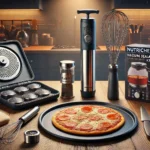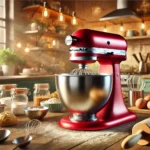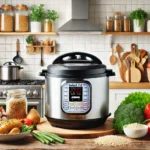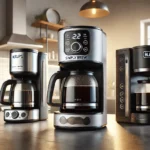One in three Americans uses plastic containers every day. But, nearly 93% of people in the U.S. have BPA in their bodies. This chemical can harm health and is found in many food containers.
BPA-free containers are now a must-have for safe kitchens. They help avoid health risks and last a long time.
Choosing the right containers is important. This guide helps pick from glass like Vtopmart to premium plastic from Chef’s Path. Safe food storage means avoiding BPA and making smart choices for meals and containers.
Understanding BPA and Its Health Implications
What is BPA and Why Should You Be Concerned?
BPA is a man-made chemical that makes plastics strong. It’s in water bottles, food packaging, and even receipts. Scientists found out BPA acts like estrogen, which can mess with our hormones. This led to big worries, and now the FDA and EU have banned it in baby products.
Health Risks Associated with BPA Exposure
- Endocrine disruption: BPA messes with hormone systems, affecting reproductive health.
- Developmental issues: Studies show prenatal exposure can change children’s behavior.
- Chronic conditions: Long-term exposure is linked to heart disease and insulin resistance.
How BPA Leaches into Food
BPA can get into food under certain conditions:
- Heat: Microwaving or hot liquids make BPA break down faster.
- Acidic foods: Foods like tomatoes or citrus can wear down plastic, releasing BPA.
- Scratches:Damaged containers let BPA leak into food.
Using non-toxic containers without BPA can help avoid these problems. Look for products that say “BPA-free” to keep your food and health safe.
BPA-free Options, Food Safety Standards, and Maintenance Tips for Long-Lasting Use
The FDA sets strict rules for fda-approved containers. They make sure these containers don’t have harmful chemicals. Brands like Rubbermaid Brilliance and Vtopmart Airtight Containers test their products to meet these standards.
The Sursip 18 oz Glass Water Bottle shows how glass can be safe. It’s made to stop chemicals from getting into food. This keeps food safe and good to eat for a long time.
- Clean containers right after use with mild soap.
- Don’t use rough cleaners that can scratch and harbor bacteria.
- Keep containers in dry places to stop mold.
Safe food storage means replacing broken or warped items fast. Glass, like Sursip, is better at handling hot foods than plastic. Choosing certified products and taking good care of them keeps food safe and containers durable for daily use.
Material Matters: Glass vs. Plastic Food Storage
Choosing between plastic vs. glass storage containers depends on your kitchen needs. Both options offer safety and convenience, but each excels in different scenarios.
Glass containers like Vtopmart Glass and Amazon Basics Glass Locking Lids resist stains and odors. They’re oven-safe and ideal for reheating. You can see what’s inside, making them great for a tidy kitchen storage containers.
Many glass sets come with secure seals. This stops leaks during meal prep.
Advantages of BPA-free Plastic
BPA-free plastic containers such as Rubbermaid Brilliance are lightweight and durable. They don’t crack easily and are safe. They’re affordable and stackable, perfect for packing lunches or freezing meals.
Modern plastics use safe materials like Tritan or PP copolyester. These avoid harmful chemicals.
When to Choose Each Material
- Glass: Opt for reheating in ovens, storing acidic foods, or showcasing meals in stylish kitchen storage containers.
- Plastic: Best for portable use, freezer storage, or families needing drop-resistant options.
Both materials are safe, but they suit different needs. Think about your storage needs before choosing. Decide between glass’s clarity and plastic’s portability.
Leading Brands Offering High-Quality BPA-free Containers
Choosing the right BPA-free containers depends on what you like and how much you want to spend. Here’s a breakdown of top brands across categories:
Glass Container Options
Glass is durable and lets you see what’s inside. Sursip has 18 oz glass water bottles with leak-proof lids. Vtopmart offers stackable airtight food storage containers. Amazon Basics has glass sets with locking lids at a good price. All are made of borosilicate glass, safe for oven and freezer.
Premium Plastic Alternatives
Rubbermaid Brilliance containers are clear and stain-resistant. They stack well. Chef’s Path adds dividers for spices and snacks. Both keep food fresh with snap-lock seals.
Budget-Friendly Picks
For great value, try KEMETHY’s 4-piece set, safe for microwaves. Freshware has containers for meal prep with portion marks. PRAKI and PANTRYSTAR offer stackable containers for storing lots.
Key Considerations
Look at lids, stackability, and dishwasher safety. DWËLLZA KITCHEN focuses on eco-friendly materials. Choose brands safe for microwaves and freezers to make your containers last longer.
Essential Features for Safe and Effective Food Storage
Choosing the right features is key to keeping food fresh and easy to access. Airtight food storage and leak-proof containers are must-haves. But, other details are important too. Brands like Rubbermaid Brilliance and Vtopmart focus on these, making them great choices.
- Airtight seals: Vtopmart’s silicone gaskets and Chef’s Path snap locks block oxygen, slowing spoilage.
- Leak-proof designs: Rubbermaid Brilliance lids and base grips prevent spills during travel or stacking.
- Material build: Thick glass or durable plastic balances strength with ease of use, avoiding cracks or warping.
- Microwave safety: Check for labels specifying oven-safe materials to avoid chemical leaching.
- Organization: Stackable shapes and compartmentalized sets (like Freshware’s meal prep containers) save space and reduce clutter.
Look for vented lids on microwave-safe options to release steam safely. Vacuum-seal containers, like certain Vtopmart models, extend freshness further. Opt for transparent bases to spot contents instantly—no more guessing what’s inside. Prioritizing these features ensures longevity and safety, whether storing leftovers or prepping meals.
Maximizing the Lifespan of Your Food Containers
Proper care keeps food-safe containers durable and good for safe food storage. Follow these steps to make them last longer:
Proper Cleaning Techniques
- Hand-wash glass containers like Sursip 18 oz Glass Water Bottles with mild soap and a soft sponge to avoid scratches.
- Use the dishwasher for BPA-free plastic options such as Rubbermaid Brilliance. Check the manufacturer’s guidelines for temperature settings.
- Soak stubborn odors with baking soda and water. Avoid abrasive cleaners that can damage seals.
Storage Best Practices
Nest Vtopmart Glass Containers properly to prevent chips. Store lids separately to avoid warping. Keep containers away from direct sunlight and heat sources to prevent warping or discoloration.
Avoiding Common Damage Causes
- Thermal Shock: Never expose glass to extreme temperature changes (e.g., microwaving empty containers).
- Scratch Prevention: Use silicone utensils with plastic containers to avoid surface damage.
- Chemical Exposure: Avoid bleach-based cleaners that weaken plastic or etch glass over time.
Maintaining containers properly keeps them in good shape and safe for food storage. By following these steps, your containers will stay functional and clean for years.
The Environmental Impact of Your Container Choice
When picking kitchen storage containers, think about their whole life. Glass containers like Vtopmart Glass Food Storage Containers and plastic ones like Rubbermaid Brilliance use different amounts of energy. Glass takes more to make but lasts longer. Plastic is lighter, which means less energy for shipping.
Sustainability Considerations
- Making glass needs more energy but it lasts longer than plastic.
- Rubbermaid Brilliance’s BPA-free plastic is better for the planet because it’s replaced less often.
- Choose containers that can go in the dishwasher and freezer to last longer.
Recycling Options for Different Materials
Recycling glass containers like Sursip 18 oz bottles means separating the lids. Plastic #5, found in Rubbermaid Brilliance, can be recycled easily. But, parts made of different materials need to be taken apart first. Make sure to clean them well before recycling.
Reducing Waste with Durable Containers
Using long-lasting containers cuts down single-use plastic by 90% in five years. Brands like Vtopmart and Sursip make parts that can be recycled, helping the environment. Choose containers that stack to save space and encourage using them again.
Check out some these top 10 gadgets or your kitchen upgrade today.
Conclusion
Choosing BPA-free containers like those from Rubbermaid Brilliance or Vtopmart keeps meals safe. Non-toxic options from Chef’s Path and Freshware protect health and the planet. Always look for certifications to avoid BPA risks.
What you choose matters: glass is durable for the oven, while KEMETHY’s BPA-free plastics are light and versatile. Brands like Amazon Basics Glass and Sursip offer safe, affordable choices. Clean them right and avoid extreme heat to make them last longer.
Looking ahead, we’ll see more eco-friendly and smart storage options. But today, picking FDA-approved containers from trusted brands helps the environment. Go for brands like Chef’s Path for tight seals or Vtopmart for stackable designs that fit your needs and values.




